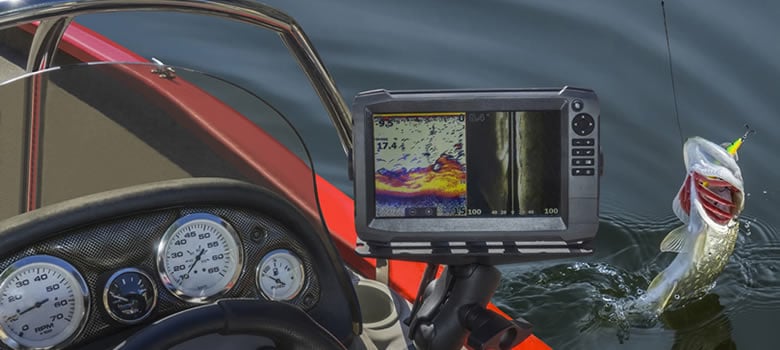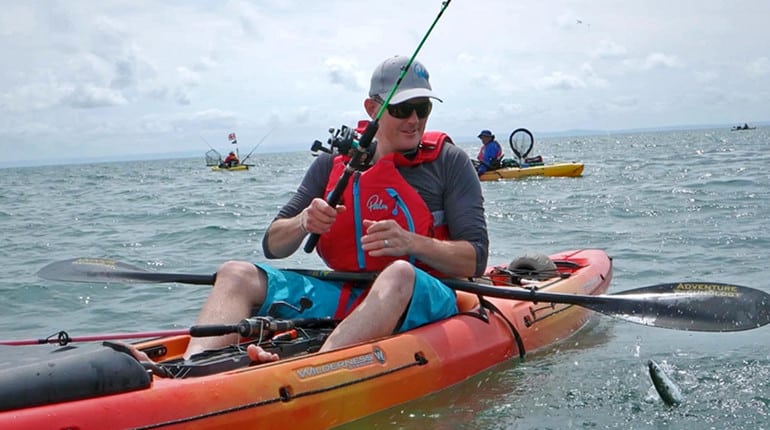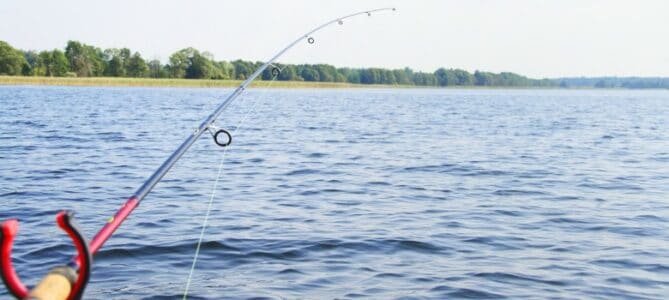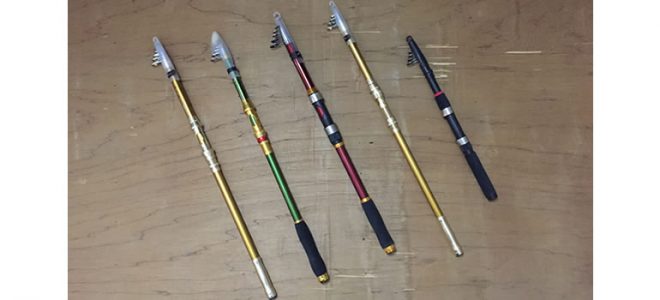If you buy via a link on this page, we may receive a commission, at no extra cost to you.Learn more
Fishfinders will help you improve your fishing. They help you to locate fish and point out how low they are. As you can see, they are very useful gadgets.
But, how do you choose one? Well, it all depends on several things such as:
- Display
- GPS Capabilities
- Water protection
- Mounting options
- Transducer
- Cone angle
- Frequency
- Side or down imaging
- Power requirements
- GPS and Mapping Capabilities
Choosing the one might take some time, given all the variables you have to consider. But don’t worry. We’ve got you covered. In today’s piece, you will find an in-depth guide on all the elements that you look for in your next fish finder. How each one impacts performance, and how each one can help you get the most out of your money. So, with no further ado. Let’s get started.

Fish Finder Display
The display is arguably the first thing that you look into in any fish finder. And it couldn’t be any other way. The display is where you see where the fish are in the water column. So, having a good display is key.
Sadly, a good display also increases the price of the device substantially.
So, let’s talk about some screen-related features.
Black and White Vs Color
Most affordable fish finders pack a black and white display. Although they get the job done, there is nothing like having a colored display. Even more so nowadays.
The lack of contrast and brightness is the main problem with black and white screens. In addition, they get rather opaque when the sun is shining directly into the screen.
In short, colored screens offer more contrast and brightness. They also remain fairly visible under direct sunlight. As a result, you will easily identify fish from other underwater structures. Plus, fishfinders with colored screens even use different colors to show depths and underwater contour.
What we are trying to tell you here is; if you can go for a fishfinder with a colored screen.
Brightness and Sunlight
Adjustable brightness is key for keeping the screen visible throughout the day. Sadly, not all fish finders offer such a feature. Typically, only the ones with colored screens do.
The advantage of these screens over the regular ones is that you can adjust the brightness depending on natural light. For example, you can crank it up on sunny days. Alternatively, you can lower it during the night, so you don’t scare fish away.
Water and Dust Protection
Most people think that all fish finders are waterproof right out of the box. So, it is wise to invest your money in something that is, in fact, waterproof. But, how do I know if my fishfinder is waterproof?
Well, you simply need to check the IP rating. It shows both intrusion and water protection. The level of shielding depends on the number that follows the IP. The first one refers to dust protection, while the second shows water resistance. The important thing to know here is that the higher the number, the more protection.
Most electronic devices rock and IPX7 water protection. The X refers to the ultimate dust protection, while the 7 shows that the device is protected up to 1 meter of immersion.
Naturally, the higher the IP rating, the more expensive the device will get. However, you can rest assured that it won’t get damaged if it gets soaked in water.
Portable, Mounted, and Wireless Fish Finders
Fishfinders are either portable or flush-mounted. The first one is a better deal if you change boats constantly or you want something compact. The main problem with them is that they pack smaller screens. So, if you are looking for something with a large display, you must look for a mounted model.
I know. You might be wondering what a mounted fish finder is? Well, these are those models that you need to fix on a gear track and pass the transducer through the hull. That’s why we only recommend these fishfinders to those who fish often and have their own craft.
Another thing that’s worth mentioning is that mounted fish finders are typically more accurate than any other model. The main problem is that you can’t use them while you are fishing from a plier or land.
Wireless fish finders are rather new. They are also very simple. They consist of a ball that you cast on the water. Said ball comes with a built-in transducer responsible for creating the signals that help you locate fish. They also have WiFi or Bluetooth that allows you to connect a compatible smartphone or tablet to it.
Versatility is the main advantage of this type of finder. You can use it from a fishing kayak, canoe, yacht, plier, or even from the shore. But beware. They lack the autonomy of the other models we discussed before. In addition, your phone or tablet will be in harm’s way as you try to locate fish.
Transducer: The Heart of The Fish Finder
Many anglers come here to ask us what a transducer is. To simply do it. It is a device capable of transforming one form of energy (input) into another (output). In this case, the transducer on the finder transforms electrical impulses into sound waves. The waves then bounce back to the transducer once they reach an object.
Transducer changes depending on the make and model. Some use more than one frequency. Others use different cone anglers. Needless to say, this has a huge impact on detail and reach. We will discuss this in detail in the next sections.
Fish Finder Cone Angles
Now you know that the transducer is responsible for producing sound waves. The reach of said sound waves depends on both frequency and cone angle. Here we will talk about the latter.
Broad cones angles are useful for covering large areas. But, as you might imagine, the waves are unable to travel deeper into the water column. That’s why many brands, such as Garmin and Lowrance try to use more than one cone angle. This way, they can give you enough detail while also covering large areas of the lake or river
Fish Finder Frequency
As we already explained before, frequency affects both details and reach. It also influences autonomy.
Most fish finders work over the range of 50 to 200 kHz. All you need to know is that low-frequency fish finders produce fewer waves. Consequently, they can travel farther in the water column. Plus, they also use less power. As a result, the battery will last longer.
On the other hand, high-frequency fish finders produce more sound waves. Therefore, they yield a more detailed image. Sadly, the waves don’t travel as far and consume more power.
Budget options typically use a single cone and frequency combination. But high-end models usually pair different frequencies with different cone angles to produce a better image. For example, some brands might pair a high-frequency transducer with a narrow cone angle to increase the reach of the waves without compromising detail.
Side or Down Imaging
Side and down imaging is another key feature of any fish finder. But what does it mean? Side-scan refers to the ability of the finder to scan what’s around the transducer. In contrast, down imaging refers to the ability of the sonar to scan what’s beneath it.
Needless to say that both are equally important. That’s the reason why most options offer both scanning methods.
Power Requirements
Most fish finders available are powered by AAA batteries. These typically are portable, with small displays, single frequencies, and fewer features. On the other hand, you can plug high-end fish finders into an external power supply. This way, you won’t need to worry about running out of batteries anytime soon.
Needless to say, having something that you can plug into an external power supply also means that you need to pay more for it. But, if you have your own craft and you are passionate about fishing, then there is no reason to invest in one of these.
GPS and Mapping Capabilities
Although fish finders are meant to be used to find fish, some of them also offer other features such as GPS, mapping, and waypoint storage. Naturally, devices that pack such features are inherently more expensive than those that don’t. But they will be worth your while
Why? Well, imagine that you hit a fishing hotspot and you are deep into the outdoors. How do you save it for later if you don’t have a map or GPS? That’s where fish finders with GPS, mapping, and waypoint storage come to the rescue. You can save the place and make your way back later.
Choosing Your Next Fish Finder
When it comes to fish finders, there is a great deal of information to digest. But if you read all this way down here, you already know said information. Therefore, you are more than able to make an educated decision on your purchase. But, just to make sure, we will do a brief summary.
Fish finder frequency, cone angle, side or down imaging, power requirements, display, and waterproofing are the most relevant features that you must look into when choosing your brand new fish finder.
If you can afford it, then try to get one with a built-in GPS system and waypoint storage. You won’t regret it.
Before you go, make sure to check our review of the best fish finders for kayaking and best ice fishing fish finders. There you will find some of the best models you can get with your money.




